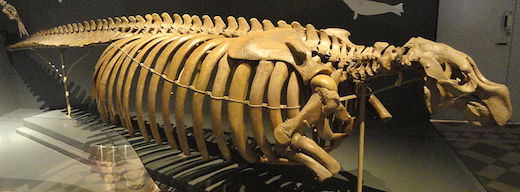Steller's Sea Cow

Extinct 1768
The Steller's sea cow grew to eight or nine meters in length. They looked sort of like a large seal, however, they had two stout forelimbs and a whale like fluke. The Steller's sea cow used its' forelimbs for swimming, walking on the shallow shore, supporting itself on the rocks, digging for algae and seagrasses, fighting, and embracing each other. The Steller's sea cow was covered with a thick hide that was black in color and very mangy, wrinkled, rough, hard, and tough. It had a huge body that made the head appear small and short. The Steller's sea cow's mouth was large, broad, and often appears to be located underneath the skull, although it is not. The mouth was small and had no teeth, but it had a double lip which resided both above and below. They had bristles that took the place of teeth and were used to pull seaweed out and to hold the food.
Habitat
The Steller's sea cow used to wide spread along the North Pacific Coast, reaching as far south as Japan and California. They inhabited the Near Islands in the historic periods. The Steller's sea cow was also known to live in herds.
Extinction
The Steller's sea cow is extinct because of hunting. No other factors have played a part in their extinction. The Steller's sea cow was hunted for its subcutaneous fat. The population was quickly wiped out by sailors, seal hunters, as well as fur traders. It only took twenty-seven years after the Europeans discovered them for them to be wiped out. By 1768, there were no more Steller's sea cows left.